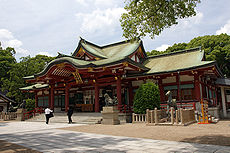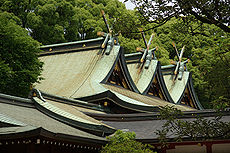
Nishinomiya Shrine
Encyclopedia


Shinto
or Shintoism, also kami-no-michi, is the indigenous spirituality of Japan and the Japanese people. It is a set of practices, to be carried out diligently, to establish a connection between present day Japan and its ancient past. Shinto practices were first recorded and codified in the written...
shrine
Jinja (Shinto)
A Shinto shrine is a structure whose main purpose is to house one or more Shinto kami....
in Nishinomiya
Nishinomiya, Hyogo
is a city located in Hyōgo, Japan, between the cities of Ōsaka and Kōbe. On April 1, 2005, the city of Nishinomiya celebrated its 80th anniversary. It is best known as the home of Kōshien Stadium, where the Hanshin Tigers baseball team plays home games and where Japan's annual high school baseball...
, Hyōgo
Hyogo Prefecture
is a prefecture of Japan located in the Kansai region on Honshū island. The capital is Kobe.The prefecture's name was previously alternately spelled as Hiogo.- History :...
, Japan
Japan
Japan is an island nation in East Asia. Located in the Pacific Ocean, it lies to the east of the Sea of Japan, China, North Korea, South Korea and Russia, stretching from the Sea of Okhotsk in the north to the East China Sea and Taiwan in the south...
. It is the head shrine of the Ebisu
Ebisu (mythology)
Ebisu , also transliterated Yebisu or called Hiruko or Kotoshiro-nushi-no-kami , is the Japanese god of fishermen, luck, and workingmen, as well as the guardian of the health of small children...
sect of Shinto, and it is said that there are about 3,500 shrines under it. Locals call the shrine ‘Ebessan’. It is famous for the Tōka-Ebisu festival, which is held on January 10 every year. Particular to this festival is the "Lucky Men" race. Begun during the Edo Period
Edo period
The , or , is a division of Japanese history which was ruled by the shoguns of the Tokugawa family, running from 1603 to 1868. The political entity of this period was the Tokugawa shogunate....
, participants gather in front of the shrine's main gate before 6 am on the 10th of January. At 6 am, the shrine's drum sounds, the gates are opened, and the assembled crowd sprints perilously 230 meters to the main hall. The top three finishers are given the title of "Lucky Men," and of those three the champion is known as the "Luckiest Man." The race has been known to attract more than 6,000 runners.
Objects of worship
Nishinomiya Shrine has three small inner shrines and each shrine enshrines one or two kamiKami
is the Japanese word for the spirits, natural forces, or essence in the Shinto faith. Although the word is sometimes translated as "god" or "deity", some Shinto scholars argue that such a translation can cause a misunderstanding of the term...
. The first shrine enshrines Nishinomiya-Ōkami, or Ebisu-no-mikoto, namely Ebisu. The kami of the second shrine are Amaterasu-Ōmikami
Amaterasu
, or is apart of the Japanese myth cycle and also a major deity of the Shinto religion. She is the goddess of the sun, but also of the universe. the name Amaterasu derived from Amateru meaning "shining in heaven." The meaning of her whole name, Amaterasu-ōmikami, is "the great August kami who...
and Ōkuninushino-Mikoto. The third shrine is for Susanoono-Mikoto
Susanoo
, also known as is the Shinto god of the sea and storms. He is also considered to be ruler of Yomi.-Myths:In Japanese mythology, Susanoo, the powerful storm of Summer, is the brother of Amaterasu, the goddess of the sun, and of Tsukuyomi, the god of the moon. All three were born from Izanagi, when...
.
History
It is not clear when this shrine was established. However, it is recorded that it was already at this site, under the name Ebisu-sha, and attracting many worshippers during the Heian PeriodHeian period
The is the last division of classical Japanese history, running from 794 to 1185. The period is named after the capital city of Heian-kyō, or modern Kyōto. It is the period in Japanese history when Buddhism, Taoism and other Chinese influences were at their height...
. For many centuries it was known as Nangu-sha, the "Southern Shrine", in reference to its status as a branch shrine of Hirota Shrine
Hirota Shrine
' is a Shinto shrine in Nishinomiya City, Hyōgo Prefecture, Japan. Nishinomiya literally means "shrine of the west," and the town is in fact named after Hirota Shrine.-Location:...
, which is located to its north in Nishinomiya. Nishinomiya Shrine itself had a similar relationship with Koshikiiwa Shrine
Koshikiiwa Shrine
' is a Shinto shrine in Nishinomiya, Hyōgo, Japan. The other name of this shrine is Ebisu Daijingū. The focus of this shrine is a megalith called 'Koshiki-iwa', literally, 'Rice Steamer Rock', because ancient Japanese thought the shape resembled a traditional rice steamer...
, which was sometimes called Kita no Ebisu, meaning the Northern Ebisu.
Access
- Nishinomiya StationNishinomiya Station (Hanshin)is a train station on the Hanshin Electric Railway Main Line in Nishinomiya, Hyōgo Prefecture, Japan. The station is called "Hanshin Nishinomiya" or "Han-Nishi" to distinguish the name from Nishinomiya Station on the JR West Tōkaidō Line and Nishinomiya-kitaguchi Station on Hankyu...
of Hanshin Main Line - Nishinomiya StationNishinomiya Station (JR West)is a train station located in Ikeda-chō , Nishinomiya, Hyōgo, Japan operated by the West Japan Railway Company . The station is on the JR Kobe Line which runs between Osaka Station and Himeji Station; part of the main Tōkaidō Line...
of JR Kobe LineJR Kobe LineThe is the nickname of portions of the Tōkaidō Main Line and the Sanyō Main Line, between Osaka Station in Osaka, Osaka Prefecture and Himeji Station in Himeji, Hyōgo Prefecture...
External links
- Nishinomiya Shrine Homepage (in Japanese)
- Nishinomiya Shrine's biggest festival "Tokaebisu" Homepage (in Japanese,one of lecturer of Kitakyushu College of Technology wrote)

